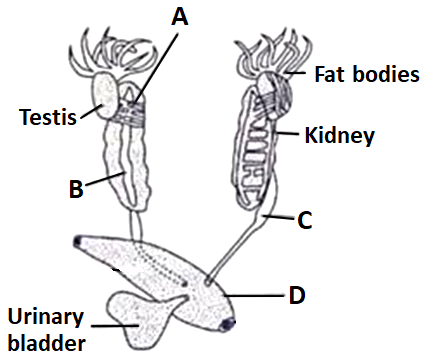Select Question Set:
Chief nitrogenous waste product in frog is -
1. Ammonia
2. Urea
3. Uric acid
4. Allantoin
Subtopic: Frogs: Anatomy (Excretory System) |
85%
From NCERT
Please attempt this question first.
Hints
Please attempt this question first.
In frog, how many pairs of cranial nerves are found?
1. 10
2. 12
3. 8
4. 31
1. 10
2. 12
3. 8
4. 31
Subtopic: Frogs: Anatomy (Nervous System) |
92%
From NCERT
Please attempt this question first.
Hints
Please attempt this question first.
The medulla oblongata passes out through -
1. Foramen magnum
2. Foramen obturator
3. Foramen of Magentie
4. None of the above
1. Foramen magnum
2. Foramen obturator
3. Foramen of Magentie
4. None of the above
Subtopic: Frogs: Anatomy (Nervous System) |
92%
From NCERT
Please attempt this question first.
Hints
Please attempt this question first.
Which of the following is false about the nervous system of frog?
1. Fore-brain includes paired olfactory lobes, paired cerebral hemispheres and unpaired diencephalon
2. Mid-brain comprises paired optic lobes and paired crura cerebri
3. Hind-brain comprises cerebellum and medulla oblongata
4. There are 10 pairs of nerves arising from brain and spinal cord.
1. Fore-brain includes paired olfactory lobes, paired cerebral hemispheres and unpaired diencephalon
2. Mid-brain comprises paired optic lobes and paired crura cerebri
3. Hind-brain comprises cerebellum and medulla oblongata
4. There are 10 pairs of nerves arising from brain and spinal cord.
Subtopic: Frogs: Anatomy (Nervous System) |
From NCERT
Please attempt this question first.
Hints
Please attempt this question first.
Frog has sense organs like sensory papillae (for touch), taste buds, nasal epithelium (smell), eyes, tympanum with internal ear (for hearing) out of these, which of the following is well-organised structure?
1. Eyes and internal ears
2. Eyes and sensory papillae
3. Internal ears and taste buds
4. Taste buds and sensory papillae
1. Eyes and internal ears
2. Eyes and sensory papillae
3. Internal ears and taste buds
4. Taste buds and sensory papillae
Subtopic: Frogs: Anatomy (Nervous System) |
80%
From NCERT
Please attempt this question first.
Hints
Please attempt this question first.
In frog, all are cellular aggregations around nerve endings except-
1. Sensory papillae
2. Taste buds
3. Nasal epithelium
4. Eyes and internal ear
1. Sensory papillae
2. Taste buds
3. Nasal epithelium
4. Eyes and internal ear
Subtopic: Frogs: Anatomy (Nervous System) |
83%
From NCERT
Please attempt this question first.
Hints
Please attempt this question first.
Which of the following sequences is correct for the passage of sperms in frog (male)-
1. Testis → Bidder's canal → Vasa efferentia → Urinogenital duct → cloaca → cloacal aperture
2. Testis → Vasa efferentia → Bidder's canal → Urinogenital duct → cloaca → cloacal aperature
3. Testis → Urinogenital duct → Bidder's canal → Vasa efferentia → cloaca → cloacal aperture
4. Testis → Vasa efferentia → Urinogenital duct→ Bidder's canal → cloaca → cloacal aperature
1. Testis → Bidder's canal → Vasa efferentia → Urinogenital duct → cloaca → cloacal aperture
2. Testis → Vasa efferentia → Bidder's canal → Urinogenital duct → cloaca → cloacal aperature
3. Testis → Urinogenital duct → Bidder's canal → Vasa efferentia → cloaca → cloacal aperture
4. Testis → Vasa efferentia → Urinogenital duct→ Bidder's canal → cloaca → cloacal aperature
Subtopic: Frogs: Anatomy (Male Reproductive System) |
82%
From NCERT
Please attempt this question first.
Hints
Please attempt this question first.
In male frog, cloaca is used to pass out -
1. Faecal matter only
2. Urine only
3. Sperms only
4. Faeces, urine and sperm
1. Faecal matter only
2. Urine only
3. Sperms only
4. Faeces, urine and sperm
Subtopic: Frogs: Anatomy (Digestive System) |
94%
From NCERT
Please attempt this question first.
Hints
Please attempt this question first.
Go through the following figure indicating the male reproductive system of frog. Identify A to D -


| A | B | C | D | |
| 1. | Bidder's canal | Adrenal gland | Urinogenital duct | Rectum |
| 2. | Bidder's canal | Adrenal gland | Urinogenital duct | Cloaca |
| 3. | Vasa efferentia | Adrenal gland | Urinogenital duct | Cloaca |
| 4. | Vasa efferentia | Thyroid gland | Urinogenital duct | Cloaca |
Subtopic: Frogs: Anatomy (Male Reproductive System) |
75%
From NCERT
Please attempt this question first.
Hints
Please attempt this question first.
For female frog, which of the following is false?
| I. | One pair ovaries is situated near kidneys |
| II. | Ovary has functional connection with kidney |
| III. | Convoluted, tubular, ciliated and glandular oviduct arises from ovary and opens into cloaca |
| IV. | Oviduct and ureter open separately into the cloaca |
| V. | A female frog can lay 2500-3000 ova at a time |
| 1. | I and II | 2. | only II |
| 3. | I and IV | 4. | IV and V |
Subtopic: Frogs: Anatomy (Female Reproductive System) |
68%
From NCERT
Please attempt this question first.
Hints
Please attempt this question first.
Select Question Set:






